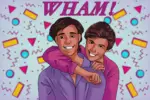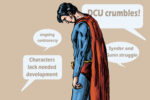“Look up in the sky! It’s a bird, it’s a plane, it’s Superman!” The 1952 television spectacular “The Adventures of Superman” opens each episode with these lines to welcome the viewer into the otherworldly hero’s life.
What is it about watching heroes defeat the bad guy, win the heart of their crush and save the town that satisfies viewers? Is it the dreamy characters coming to life, or does fulfillment come from projecting onto the characters that make up cherished fiction? While comics can serve as glossy escapism from daily life, these stories can develop much greater meaning than their humble beginnings.
For instance, take the Superman image. The signature “S” symbol paired with bright primary colors and a swooping hairdo are easily recognized in the public eye — even by those who aren’t die-hard worshippers of the character. However, this also sparks the question of what the character’s personality means on an individual level, seeing as the reader has the ultimate power to define what Superman is going to stand for in their eyes.
In October 2021, CBR revealed that the newest version of Superman, Jon Kent, is coming out as bisexual. In the upcoming November publication “Superman: Son of Kal-El #5,” this revamped Superman will get to fight crime while exploring what it means to live his truth. The announcement was an epic first for the character, made even sweeter as the news went public on National Coming Out Day.
Those who are unfamiliar with Jon Kent have good reason to be, considering the character was only introduced to the DC comic scene in 2015. Because he is the son of Clark Kent and Lois Lane, Jon Kent has large shoes to fill as the successor of these traditional faces in comic book canon.
The November publication will see Jon Kent get close with a pink-haired reporter/hacktivist named Jay Nakamura. Their friendship becomes something more as the chaos of saving the day catches up to Superman. A blooming new relationship with the sweet reporter shows that, as Variety said, “The Kryptonian apple does not fall far from the tree.” With parallels to the iconic relationship of his parents, Jon Kent’s love story will resonate with the classic storyline and revive the character with a timely update.
Saving the day and getting the boy is not a statement that someone is used to saying about Superman, but it’s needed now more than ever. Tom Taylor, the main writer to bring Jon Kent’s bisexual Superman to life, said to CBR, “I’ve always said everyone needs heroes and everyone deserves to see themselves in their heroes and I’m very grateful DC and Warner Bros. share this idea.”
Joining forces with the artistic talents of John Timms, the pair paves the way for a new age of what Superman can — and should — look like. At the same time, the new Man of Steel also gets to join the likes of other LGBTQ+ superheroes today, from Batwoman to Loki and everyone in between.
Jon Kent is in for discoveries that are both familiar and totally distant to the reader as he navigates the responsibility of being the “new” Superman and trying to make sense of who he is. In other words, as IGN put it, “Can he find the balance between costumed and civilian lives that’s proven so elusive so far?” The facets of exploring identity that everyone comes face-to-face with at some point in life become extremely complicated when combined with the background of a superhero legacy.
Since the main announcement of Jon Kent’s identity on the official Superman Twitter account, fans from all over have responded with an outpouring of love. Every response from “I knew this was coming but I LOVE to see it!” to “Happy for him, but a reporter again?” can be found beneath the initial thread. It’s safe to say that the people have spoken, and they are more than ready for Superman to win the “handsome reporter” of his dreams.
Knowing that passionate fans are unstoppable when it comes to sharing their feelings, the response to Jon Kent is also crucial to the character’s posterity. Despite the supportive opinions of Superman’s fandom, there’s always going to be someone who wants to push back against these changes. Additionally, the embeddedness of the comic industry in pop culture today means that these storylines and characters are going to be the subject of criticism on the social media stage.
While the Superman Homepage site — a fan’s hub for all things Superman — stated that Jon Kent’s LGBTQ+ identity is “a bold new direction” for the character, backhanded compliments like this express an obvious dissatisfaction toward the choice. Hesitation around Jon Kent can be very casual, such as “Saturday Night Live” joking about how small and trivial this change is to the classic comic. However, the character has unfortunately been a magnet for anger by longtime followers of the Man of Steel.
For example, Wendy Rogers tweeted her frustration with Jon Kent’s identity. Some highlights from her 280-character rant include, “Hollywood is trying to make Superman gay and he is not. Just rename the new version Thooperman so we can all know the difference and avoid seeing it.” Putting aside her status as the senator for the state of Arizona — and therefore holding a large and influential platform — Rogers targets the very media that she chooses not to engage with.
The rich irony lies in the fact that every critique of this LGBTQ+ Superman is based on a viewer disliking that media simply because it is not something that they personally enjoy reading or watching. When somebody feels so strongly opposed to a fictional character for being different, it should also be a signal for that viewer to put the media down and find something new to entertain themselves with. Though the process of changing something “timeless” will obviously incite debate, it’s still surprising that such uproar can come from the most unlikely of places.
Even a “Superman” himself had much to say on the subject. The actor Dean Cain, who portrayed a version of the Man of Steel in the 1990s, voiced his stance on the impact of Jon Kent’s Superman. In a recent interview with Fox News, Cain stated, “[DC Comics] said it’s a bold new direction, I say they’re bandwagoning.”
While it’s true that there has been an increase in the number of LGBTQ+ characters in the DC Comic universe, the implication of “bandwagoning” makes it seem like Jon Kent’s identity was a careless choice. Cain continued, “There’s real evil in this world today, real corruption and government overreach … It’d be great to tackle those issues.” This statement attempts to call out a lack in Superman that isn’t there. Just because Superman now dates a man doesn’t mean that he’s any less of a “heroic Superman” than before. DC Comics was mindful of this type of reaction to Jon Kent’s Superman; yet, the benefits of his presence still outweigh this outpouring of degrading comments.
No matter how much hatred Jon Kent has received for being his authentic self, there are an equal number of conversations — if not more — to be held about the wonders and positivity that he brings to the scene. Comedian host Amber Ruffin took to the screen to call out fans whose agitation was more dramatic than expected. On her show, she yelled with exasperation, “If a comic book character being bisexual ruined your childhood, your childhood was trash to begin with.” The bluntness of her response is shocking yet true, considering the extent of the emotional reaction to Jon Kent’s identity in such a short time period. Nevertheless, Ruffin points out that this is a minuscule news story to get red-hot angry over.
Even if a person doesn’t like this piece of media, the reality remains that there is someone out there who needs this representation in a fictional character. Toward the end of her rant, Ruffin notes that Jon Kent is making strides for children everywhere who are feeling unrecognized by their favorite pieces of media. Emphasis on the following statement speaks volumes to the kinds of lasting change that this bisexual Superman will create: “One day, that child is going to pick up a comic book and see an iconic character that’s associated with strength, honesty and America, and they’re gonna see that person is just like them.” Negativity toward Jon Kent ends up piecing together conversations about stigmatized subjects in fiction, including the representation of LGBTQ+ characters in the comic realm.
Although there’s hope for minds and hearts to come around to a bisexual Superman, people will still gravitate to what they like. Reconciling the old with the new becomes harder when there’s so much comfort in the familiar, especially when it comes to fiction. Thankfully, comic books come with a built-in failsafe for those who have a harder time accepting changes as others do.
The multiverse theory is the idea that multiple timelines of the universe exist, with several different “versions” of everybody. This means that there’s a world with Jon Kent as a bisexual Superman successor, and one where Clark Kent is forever Superman. Most big-name comic publications — think DC Comics and Marvel Comics — rely on this multiverse theory as the end-all, be-all solution for full audience satisfaction. In a statement made by Jim Lee of DC Comics, he said, “We talk a lot about the power of the DC Multiverse in our storytelling and [Jon Kent] is another incredible example.” Providing the chance for everyone’s favorites to exist in different iterations across time guarantees that comics fit all tastes.
For some, Jon Kent is the long-awaited icon to spotlight identity and heroism within the comic genre. For others, good old Clark Kent will be the only Superman for their hearts. Regardless of which Superman takes up real estate in your comic book memories, there’s no doubt that Jon Kent is going to touch the lives of current and future fans. Among all the hatred for this new Superman, there remains at least one bit of hope: If he can make one reader feel less like an outsider, then he’s fulfilled his heroic duty.

















